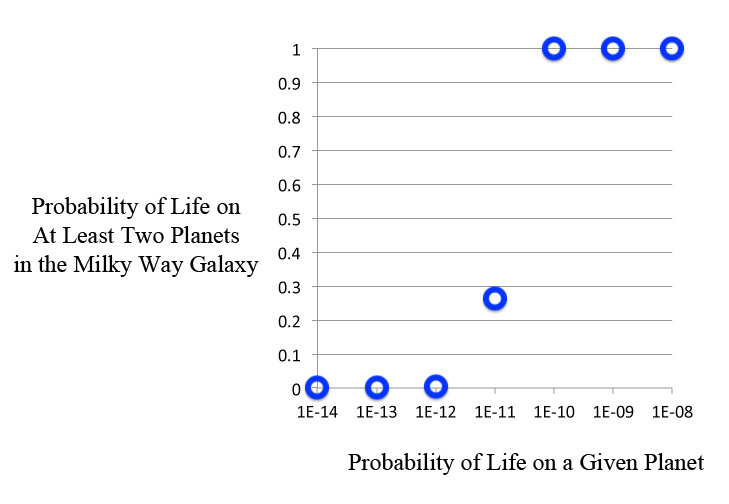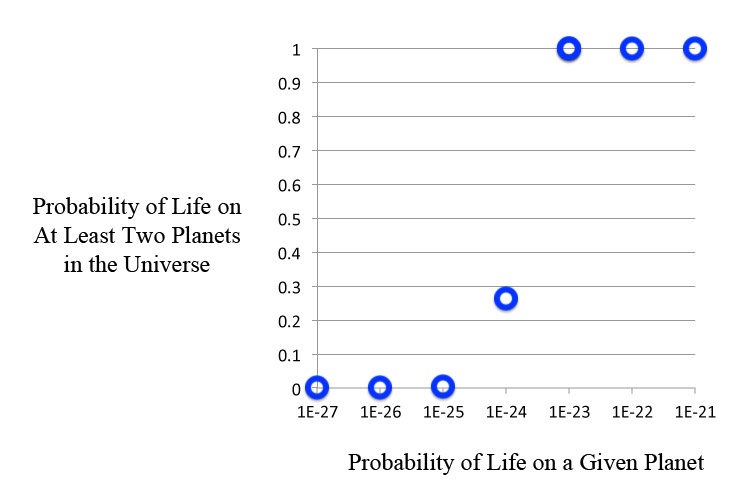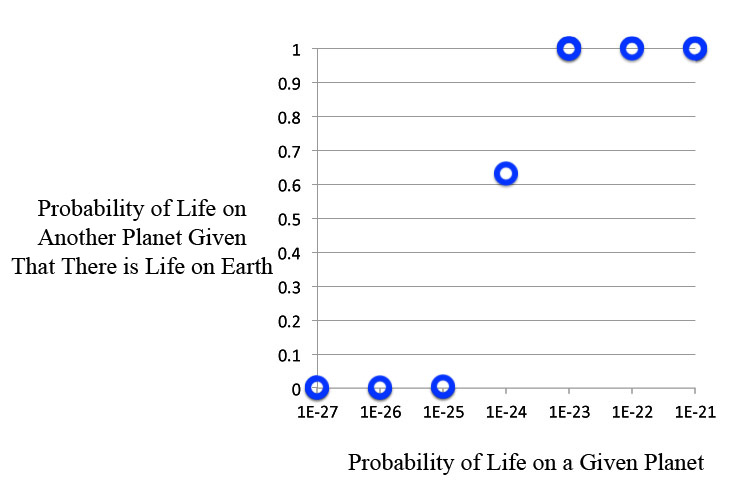Carl Sagan
and
Cosmos
(And a Few Comments on the
Probability of Life in the Universe)

Carl Sagan
He didn't say it exactly.
(Click on image to zoom in and out.
By now everyone knows - except a news outlet that stated the contrary (and so shall remain nameless) - that Carl Sagan never said "Billions and Billions". He did use the word "Billions" as well as "Millions" and "Trillions" to talk about the size of the universe. But he did not say "Billions and Billions".
We must be more specific. It was on the thirteen-part television mini-series Cosmos: A Personal Voyage that Carl did not say "Billions and Billions".
Because of Cosmos, some people who had never had any interest in science in general and astronomy in particular became some of Carl's biggest fans. One viewer was amazed the way Carl could hold his attention simply by talking.
First aired in 1980 - decades ago now - the original special effects, narration styles, and delivery seem a bit dated and - dare we say it? - even hokey. That's to be expected. But at least the cinematography included wide and medium shots and was not made up of - as is now de rigueur in motion pictures - nothing but close-ups of talking heads that leave no facial blemish unfilmed.
Today of course people debate whether the original Cosmos: A Personal Voyage was better than the 2014 show, Cosmos: A Spacetime Odyssey with Neil deGrasse Tyson (also a famous astronomer and physicist). Of course the new Cosmos used up-to-date computer animations and also featured new findings of astronomers and cosmologists. All in all, a lot of people seem to think the new version edges out the old, but many fans think you can't really watch the one without the other.
Certainly for the time, the special effects of Carl's Cosmos were quite good. But today's audiences, so used to a plethora of glitzy flashing backgrounds and lightning-like camera pans, will be surprised at how little actual animation there is. When explaining how Eratosthenes measured the circumference of the earth around 200 BC, Carl held up a flexible sheet of plastic with two miniature obelisks attached. By bending the sheet, Carl showed how the shadow lengths differ because the Earth's surface isn't flat. But lest we be criticized as die-hard traditionalists, we do have to admit that an animation would have illustrated the method better. But in 1980 electronic graphics was not the routine tool it is today and animation was time consuming and increasingly expensive.
[For those who want to see a rather simplistic, nay, archaic, computer animation of Eratosthenes' method, just click here.]
What will grab today's viewers is Carl's speaking style. It is, well, it's unique. Certainly Carl was much more laid back than today's television presenters who seem to think you have to shout to be heard.
Carl's style immediately became the subject of satire. When speaking to the viewer he would emphasize certain letters by accenting and stretching them out. And yes, he would say "Billions" and "Trillions" and even "Millions".
About the closest Carl got to the famous non-quote was in the first episode where he said, "There are a hundred Billion galaxies, and a Billion Trillion stars."

Johnny Carson
He said it.
The "Billions and Billions" quote was actually from a skit on an episode of The Tonight Show with Johnny Carson which aired shortly after Cosmos. Johnny played a less than convincing Carl (the hairstyle wasn't even right) and many of the jokes are dated. But Carl was a frequent guest on the Tonight Show - from the early 1970's until the end of his life. Carl even borrowed from Johnny's skit when choosing the title for his last book: Billions and Billions: Thoughts on Life and Death at the Brink of the Millennium. Carl died in 1996 at age 62.
Of course, Carl was not just a television presenter and popularizer of science. He was the David Duncan Professor of Astronomy and Space Sciences at Cornell University and Director of the Laboratory for Planetary Studies. As a professor he published original research in the world's major scientific journals. One paper written just a few years before his death was "Endogenous Production, Exogenous Delivery and Impact-Shock Synthesis of Organic Molecules: An Inventory for the Origins of Life." He also co-authored "Optical Constants of Organic Tholins Produced in a Simulated Titanian Atmosphere: From Soft X-ray to Microwave Frequencies". The origins of life was one of Carl's major interests.
Now Carl would venture his opinion that with all the Millions, Billions, and Trillions of stars, then on at least one of these planets life could reasonably be expected to form. And since we now know that life can exist in extreme conditions - high temperatures, elevated pressures, and bombarded by high energy radiation - many people consider finding life on other planets more and more likely. But how likely is the big question.
An Official Yet Humble CooperToons Opinion is that trying to calculate the actual probability of extra-terrestrial life is pointless, just as is trying to prove which of the various Ontological Arguments are correct. The answer is just too sensitive to what ultimately are arbitrary assumptions.
So if you want, you can - quote - "prove" - unquote - that life is 100% certain to exist on some planet other than the Earth. Or with a nearly infinitesimal shift in assumptions, you can "prove" that life is impossible to exist elsewhere.
Ha? (To quote Shakespeare.) You can prove it's a 100% probability for life to exist elsewhere - and also that there's a 0 % probability for life to exist? And with almost the same assumptions?
Yes, that's exactly what we mean.
Well, we would really like to see how to determine such probabilities.
I thought you would as Captain Mephisto said to Sidney Brand. It's very simple really. And it takes nothing more than middle school math.
At this point we will anticipate that on reading the following, the mathematicians will go into spittle-flinging diatribes that these calculations assume that life is equally likely to form on all planets. This, they say, is absurd. Some planets may be in conditions where life is virtually certain to form. But on other planets - like the Mercury - it would be impossible or certainly less likely.
Well, perhaps. But in any case such arguments are not really relevant to what we're doing. We are going to show how sensitive the calculations are to the individual probability assignments. And in any case, we will show that if you craft your wording right, then the definitions will pan out.
And rather than use a purely algebraic approach - which gets rather messy - we'll take a numerical approach. In other words, we'll work out the equations using actual numbers even though at first the numbers won't be that realistic. Once we have the equations, we'll then stick in the realistic numbers. You'll get the idea as we go along.
We start off simple. Let's assume we're looking at a solar system with 10 planets - call them Mercury, Venus, Earth, Mars, Jupiter, Saturn, Uranus, Neptune, Pluto, and Eris. If the odds are 10 % that one of these planets will produce life, what is the probability that at least one of the planets will have life?
Well, if there's ten planets and the odds are ten percent one planet will form life, you might think that the odds are 100 % that life will spring up on one of them.
And you'd be wrong.
Look at it this way. If the odds are 10 % that a given planet will harbor life, then the odds that a planet will not form life is 1 - 0.1 = 0.9 or 90%.
So the odds that none of the planets will have life is:
| Probability of No Life on All Ten Planets | = | 0.9 X 0.9 X 0.9 X 0.9 X 0.9 X 0.9 X 0.9 X 0.9 X 0.9 X 0.9 | ||
| = | 0.910 | |||
| = | 0.349 | |||
| = | 35 % |
So the probability that life will exist on at least one planet is:
| Probability of Life on At Least One Planet |
= | 1 - 0.349 | ||
| = | 0.651 | |||
| = | 65 % |
But what if we want to know the likelihood that life would form on another planet. Or rather what's the probability we can have life on at least two planets?
This is a bit trickier question, but still solvable.
We need to calculate:
| Probability of Life on At Least Two Planets |
= | 1 | - | (Probability of Life on No Planets or Probability of Life on Exactly One Planet) |
First remember we already calculated that the probability that we have life on no planets was 35 %.
And the probability that exactly one planet has life is calculated in two parts.
First we calculate the probability that there is life on one specific planet. This is the probability there will be life a given planet times - which is 10% - and the probability that there is no life on the other nine planets which is 90% per planet.
So the probability that there is life one specific planet is:
| Probability of Life on One Specific Planet | = | 0.1 × 0.99 | ||
| = | 0.1 × 0.387 | |||
| = | 0.0387 | |||
| = | 3.9 % |
But there are 10 planets in all. So the odds that there is life on exactly one planet but we don't specify which one is ten times the probability we have life on one specific planet.
So the next step is to multiply our previous answer by ten.
| Probability of Life on Exactly One Planet | = | 10 × 0.0387 | ||
| = | 0.387 | |||
| = | 39 % |
So the probability of life being on no planets OR on exactly one planet is:
| Probability of Life on No Planets or Probability of Life on Exactly One Planet | = | (Probability of Life on No Planets) + (Probability of Life on Exactly One Planet) | ||
| = | 0.349 + 0.387 | |||
| = | 0.736 |
So we calculate the probability for life on at least two planets is:
| Probability of Life on At Least Two Planets |
= | 1 | - | (Probability of Life on No Planets or Probability of Life on Exactly One Planet) | ||
| = | 1 | - | 0.736 | |||
| = | 0.264 | |||||
| = | 26 % |
Now eins mehr these calculations are for illustrative purposes only. Whether there is really a 26 % probability that two planets out of ten have life depends on how accurate our original assumptions were. Assumptions we admit are pretty shaky.
But now we'll get a bit more realistic. In our Milky Way galaxy a common estimate is there are about 100,000,000,000 planets. As Carl would say that's one hundred Billion planets. In scientific notation that's 1 × 1011.
All right, let's suppose the probability that one of those planets has life is one out of a hundred billion. That is the probability is 1/100,000,000,000.
Now if you plug our new numbers into the equations we used above, you get the following estimates:
| Number of Planets | 100000000000 |
| Probability of Life On Any Given Planet | 0.00000000001 |
| Probability of Life On No Planet | 0.369 |
| Probability of Life On Exactly One Planet | 0.368 |
| Probability of Life On No Planets Or Exactly One Planet | 0.736 |
| Probability of Life On At Least Two Planets | 0.264 |
You'll notice that this number is the same as when we had 10 planets where the probability of life on any given planet was 0.1. In fact, you can prove that if you have 10x planets, and a 10-x probability for life on any given planet, then the probability that there will be life on at least two planets is 0.264241179 or approximately 26 %.
[Hint: For the proof, it's necessary to know that the limit of (1-1/x)x as x goes to infinity is equal to 1/e where e is the natural exponent constant (that is, Euler's Number), 2.718281828 etc., etc. The proof, though, is rather lengthy.]
But now keep with our 100 Billion planets. But we will increase the probability that life can occur on any given planet to 1 out of ten billion. The new probability is 1/10,00,000,000. Then our numbers become:
| Number of Planets | 100000000000 |
| Probability of Life On Any Given Planet | 0.0000000001 |
| Probability of Life On No Planet | 0.0000454 |
| Probability of Life On Exactly One Planet | 0.000454 |
| Probability of Life On No Planets Or Exactly One Planet | 0.0004994 |
| Probability of Life On At Least Two Planets | 0.9995 |
Hm. So this slight change in probability now tells us the odds are essentially 100 % that there will be life on two planets.
Now let's decrease the probability that life will occur on a given planet to 1 out of 1,000,000,000,000. That is one out of a trillion.
So we get:
| Number of Planets | 100000000000 |
| Probability of Life On Any Given Planet | 0.000000000001 |
| Probability of Life On No Planet | 0.905 |
| Probability of Life On Exactly One Planet | 0.0905 |
| Probability of Life On No Planets Or Exactly One Planet | 0.995 |
| Probability of Life On At Least Two Planets | 0.00468 |
So now it's virtually impossible that there's life on two planets!
Keeping this up with different probabilities, we end up with the following graph:

You can do additional calculations expanding the number of planets even to those in the entire universe. Some astronomers estimate this to be 1,000,000,000,000,000,000,000,000 (or 1024) planets. But you still get the all-or-nothing plot except for a very narrow region of probabilities.

Yes, yes, you say. This is all well and good. But we know there is life on Earth. What is the probability that there is life on at least one other planet besides the Earth?
Well, we've already calculated that, sort of. This is the same as asking what is the probability that there is life on the number of planets minus 1. For instance, if we are using the number of planets in a solar system with 10 planets, then we calculate the probability that there is life on at least 9 planets. So keeping with the probability that life on any given planet is 0.1, our table is:
| Number of Planets | 9 |
| Probability of Life On Any Given Planet | 0.1 |
| Probability of Life On No Planet Other Than Earth | 0.387 |
| Probability of Life on At Least One Other Planet than Earth | 0.612 |
So that means that if there's already life on one particular planet - Earth - then the odds are still over 60 % that there's life on one of the other planets.
But what if we're talking about life in our galaxy, the Milky Way?
Well, we just subtract 1 from the total number of planets. So keeping the probability of life on any given planet as 1 out of 100,000,000,000, we get:
| Number of Planets | 99999999999 |
| Probability of Life On Any Given Planet | 0.00000000001 |
| Probability of Life On No Planet Other Than Earth | 0.368 |
| Probability of Life on At Least One Other Planet than Earth | 0.632 |
Now you might suspect - and you would be right - it doesn't matter if we use 100,000,000,000 planets of 99,999,999,999 planets, we'd still get very nearly the same probability plot. And you'd be right.

So the probability of life elsewhere is still 0 % or 100 % except for a small narrow probability region.
Finally, some students of astronomy and cosmology may say, hold on there, Pilgrim! There is the possibility that our universe is actually infinite. With an infinite universe, the answers become more complex.
If there is a finite probability that life will arise on some planet and you have infinite planets, then there is a certainty that life will arise. Not only that, there will be an infinite number of planets with life.
And since we know that life has arisen on Earth, then there is indeed a finite probability for life arising on a planet. With an infinite universe, there must be infinite planets with life.
But ... (and you knew there would be a "but").
If instead of finite probabilities, let's consider infinitesimal probabilities - that is, with numbers that are larger than zero but smaller than any real number (yes, such numbers exist as you can learn if you click here). Then even in an infinite universe, we have an option that there is indeed only finite planets with life. And maybe only one - the Earth.
So what, as Flakey Foont asked Mr. Natural, does it all mean?
It means - not the answer that Mr. Natural gave - but that the question of the probability of life elsewhere in our universe is unanswerable. At least it is with our current information. Whether there is life on another planet will have to wait until we discover it.
At the risk of belaboring the point, we will belabor the point. As long as we have absolutely no real idea of the probability that any given planet will harbor life, all we can say is it's somewhere between zero and 100 %.
The good news, though, is we are left with a concrete conclusion from what may seem rather wishy-washy calculations.
And that conclusion is that if someone says - and Carl never did - "With all the other stars and planets in the universe, there must be life somewhere else in the universe", then you know with absolutely certainty that this statement is incorrect.
And if someone says, "With the low probability that the conditions needed for life can arise and with life already on our planet, it's impossible that life can arise anywhere else", then you know that this statement is incorrect, too.
And as Sidney Brand said to Captain Mephisto ...
References
"Carl Sagan, Cornell Astronomer, Dies Today in Seattle", David Brand, Cornell Chronicle, December 20, 1996
Cosmos: A Personal Odyssey, Carl Sagan (presenter), KCET, Carl Sagan Production, British Broadcasting Corporation, Polytel International (Internet Movie Database).
Cosmos, Carl Sagan, Random House, 1980.
The Tonight Show with Johnny Carson, Johnny Carson (Host), NBC, November 20, 1980.
"Endogenous Production, Exogenous Delivery and Impact-shock Synthesis of Organic Molecules: An Inventory for the Origins of Life," Christopher Chyba and Carl Sagan, Nature, Vol. 355, pp. 125 - 132, 1992.
"Optical Constants of Organic Tholins Produced in a Simulated Titanian Atmosphere: From Soft X-ray to Microwave Frequencies", B.N. Khare, Carl Sagan, E.T. Arakawa, F. Suits, T.A. Callcott, M.W. Williams, Icarus, Volume 60, pp. 127 - 137.
"The Milky Way's 100 Billion Planets", NASA, April 25, 2012.
"How Many Stars Are There in the Sky?", Megan Garber, The Atlantic, November, 2013.
"How Many Stars Are In The Universe?", Elizabeth Howell, Space.com, May 17, 2017
"If the Universe Is Infinite Does That Mean There Is an Infinite Number of 'Me's?", Karen Masters, Ask an Astronomer, cornell.edu.